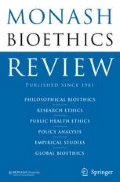Abstract
Disorders of consciousness include coma, the vegetative state and the minimally conscious state. Such patients are often regarded as unconscious. This has consequences for end of life decisions for these patients: it is much easier to justify withdrawing life support for unconscious than conscious patients. Recent brain imaging research has however suggested that some patients may in fact be conscious.
We argue that these new findings should lead us to be more cautious with regard to end of life decisions for this patient group. Additionally, we argue that if their lives are to be ended, then increased caution should be exercised to avoid undue suffering.
As a consequence, the already difficult ethical and clinical questions surrounding these patients are made even more difficult with regard to making and acting on end of life decisions, as well as with regard to quality of life prognoses. The best we can hope for is that research both on disorders of consciousness and on the neural correlates of consciousness will progress more and make these kinds of questions easier to address in the future.
Similar content being viewed by others
References
Baars, B.J. 1997. In the Theater of Consciousness: The Workspace of the Mind. Oxford, Oxford University Press.
Bayne, T. 2007. ‘Conscious states and conscious creatures: Explanation in the scientific study of consciousness’. Philosophical Perspectives 21(1): 1–22.
Block, N. 1995. ‘On a confusion about a function of consciousness’. Behavioral and Brain Sciences 18: 227–287.
Block, N. 2008. ‘Consciousness, accessibility, and the mesh between psychology and neuroscience’. Behavioral and Brain Sciences 30(5–6): 481–499.
Boly, M., Phillips, C. et al. 2008. ‘Intrinsic brain activity in altered states of consciousness’. Annals of the New York Academy of Sciences 1129 (Molecular and Biophysical Mechanisms of Arousal, Alertness, and Attention): 119–129.
Buckner, R.L., Andrews-Hanna, J.R. et al. 2008. ‘The brain’s default network: Anatomy, function, and relevance to disease’. Annals of the New York Academy of Sciences 1124(1): 1–38.
Chalmers, D. 2000. ‘What is a neural correlate of consciousness?’ Neural Correlates of Consciousness: Empirical and Conceptual Issues. T. Metzinger. Cambridge, Mass., MIT Press.
Demertzi, A., Vanhaudenhuyse, A. et al. (2008). ‘Is there anybody in there? Detecting awareness in disorders of consciousness’. Expert Review of Neurotherapeutics 8(11): 1719–1730.
Gallagher, S. 2000. ‘Philosophical conceptions of the self: implications for cognitive science’. Trends in Cognitive Sciences 4(1): 14.
Haynes, J.D. 2009. ‘Decoding visual consciousness from human brain signals’. Trends in Cognitive Sciences 13(5): 194–202.
Hohwy, J. 2009. ‘The neural correlates of consciousness: New experimental approaches needed?’ Consciousness and Cognition 18(2): 428–438.
Laureys, S., Faymonville, M.E. et al. 2000. ‘Restoration of thalamocortical connectivity after recovery from persistent vegetative state’. Lancet 355: 1790–1791.
Levy, N. 2008. ‘Going beyond the evidence’. The American Journal of Bioethics 8(9): 19–21.
Merker, B. 2007. ‘Consciousness without a cerebral cortex: A challenge for neuroscience and medicine’. Behavioral and Brain Sciences 30(1): 63–81.
Naccache, L. 2006. ‘Is she conscious?’ Science 313: 1395–1396.
Nagel, T. 1974. ‘What is it like to be a bat?’ Philosophical Review 83: 435–450.
Owen, A.M. 2008. ‘Disorders of consciousness’. Annals of the New York Academy of Sciences 1124(1): 225–238.
Owen, A.M., Coleman, M.R. et al. 2006. ‘Detecting awareness in the vegetative state’. Science 313(5792): 1402.
Panksepp, J., Fuchs, T. et al. 2007. ‘Does any aspect of mind survive brain damage that typically leads to a persistent vegetative state? Ethical considerations’. Philosophy, Ethics, and Humanities in Medicine 2(1): 32.
Rosenthal, D.M. 1986. ‘Two concepts of consciousness’. Philosophical Studies 94: 329–359.
Schacter, D.L., Addis, D.R. et al. 2008. ‘Episodic simulation of future events: Concepts, data, and applications’. Annals of the New York Academy of Sciences 1124(1): 39–60.
Scoville, W.B. and Milner, B. 1957. ‘Loss of recent memory after bilateral hippocampal lesions’. Journal of Neurology, Neurosurgery and Psychiatry 20: 11–21.
Tononi, G. 2005. ‘Consciousness, information integration, and the brain’. Progress in Brain Research. S. Laureys, Elsevier. Volume 150: 109–126.
Tononi, G. and Koch, C. 2008. ‘The neural correlates of consciousness: An update’. Annals of the New York Academy of Sciences 1124: 239–261.
Author information
Authors and Affiliations
Rights and permissions
About this article
Cite this article
Hohwy, J., Reutens, D.C. A Case for Increased Caution in End of Life Decisions for Disorders of Consciousness. Monash Bioethics Review 28, 26–37 (2009). https://doi.org/10.1007/BF03351311
Published:
Issue Date:
DOI: https://doi.org/10.1007/BF03351311




